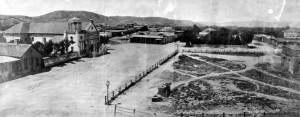Bernard-Henri Lévy’s 2006 book, American Vertigo, received, via Garrison Keillor, one of the most famous and harshest slams ever in the New York Times Book Review. The French writer’s volume grew from a series of articles he penned for the Atlantic, which saw him retrace Tocqueville’s path across America. An excerpt from one of the Atlantic pieces, in which Lévy looked at the unfathomable city known as Los Angeles:
“A legible city has to have a heart, and this heart must be pulsating. It has to have, somewhere, a starting point from which, one feels, the city was produced, and from which its mode of production is still intelligible today. It has to have a historical neighborhood, if you like, but one whose historicity continues to shape, engender, inspire, the rest of the urban space. But this place, too, is nonexistent. In Los Angeles there is nothing like the old neighborhoods from which you feel, almost physically, that the European cities, or even New York, have emerged. They do show me the old neighborhood. Kevin Starr, the excellent California historian, takes me not far from Chinatown, to Olivera Street and Old Plaza, which are supposed to be the nucleus of what was once called El Pueblo de Nuestra Señora la Reina de Los Angeles. But they are dead places. It’s a neighborhood frozen in time. However much Starr leaps from house to house, with his considerable bulk proving surprisingly agile, with his ink-blue too-warm suit and his bow tie that makes him look like a private eye out of Raymond Chandler, to explain to me how gargantuan Los Angeles was born from this tiny seed; for all this, something isn’t right. You don’t feel any possible common denominator between this stone museum, these relics, and the vital, luxuriant enormousness of the city. And the truth is that with its pedestrian islands and its restored façades, its profusion of typical restaurants and its stands selling authentic Mexican products, its wrought-iron bandstands, its cobblestones, the varnished wood of the Avila Adobe, which is supposed to be the first house in the neighborhood, this street makes me think of all the fake “heritage towns” that I keep running into in America.
For an illegible city is also a city without a history.
An unintelligible city is a city whose historicity is nothing more than an ageless remorse.
And a post-historical city is, I fear, a city about which one can predict with some certainty that it will die.”
••••••••••
Bernard-Henri Lévy on the Daily Show in 2006:
|
|
||||
Tags: Bernard-Henri Lévy, Garrison Keillor, Jon Stewart, Kevin Starr

